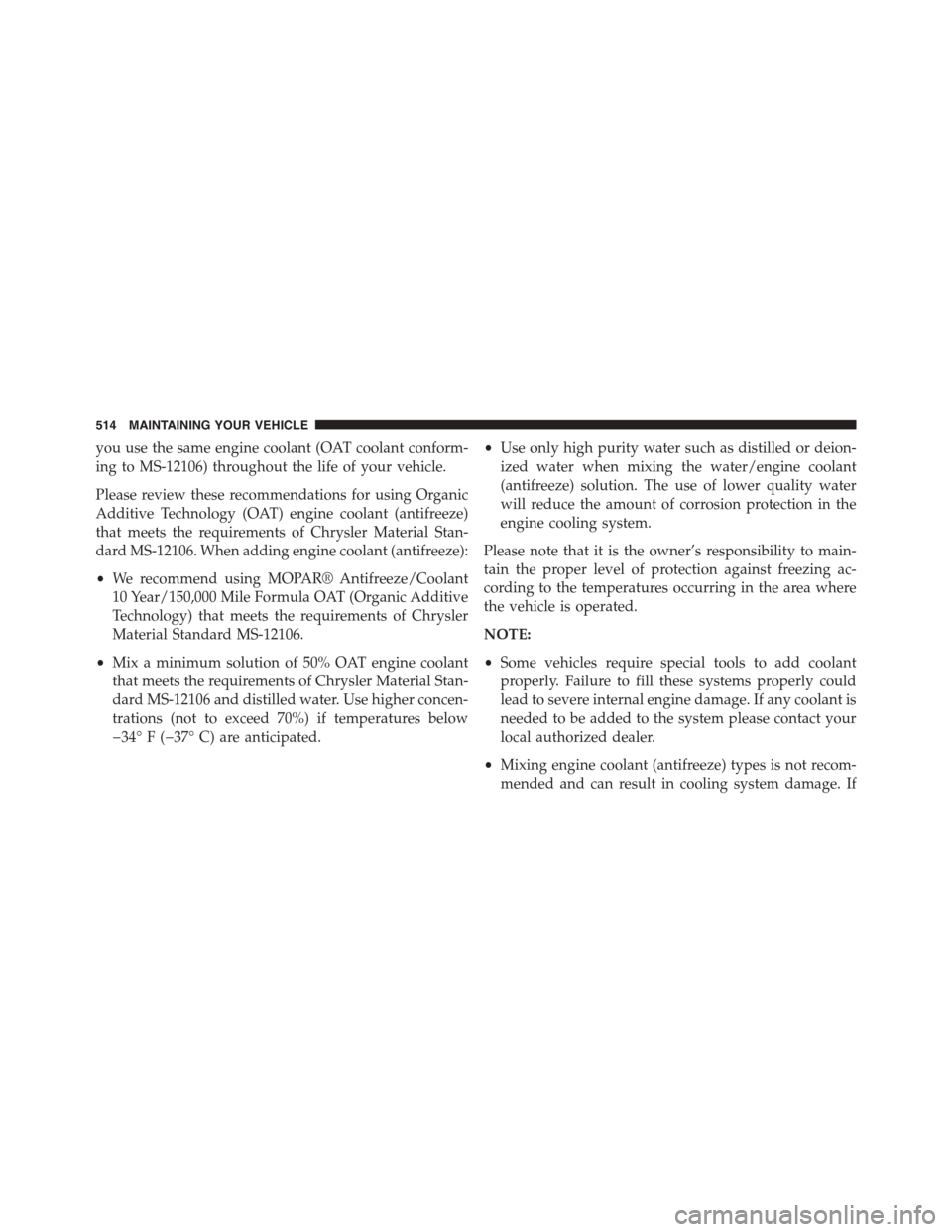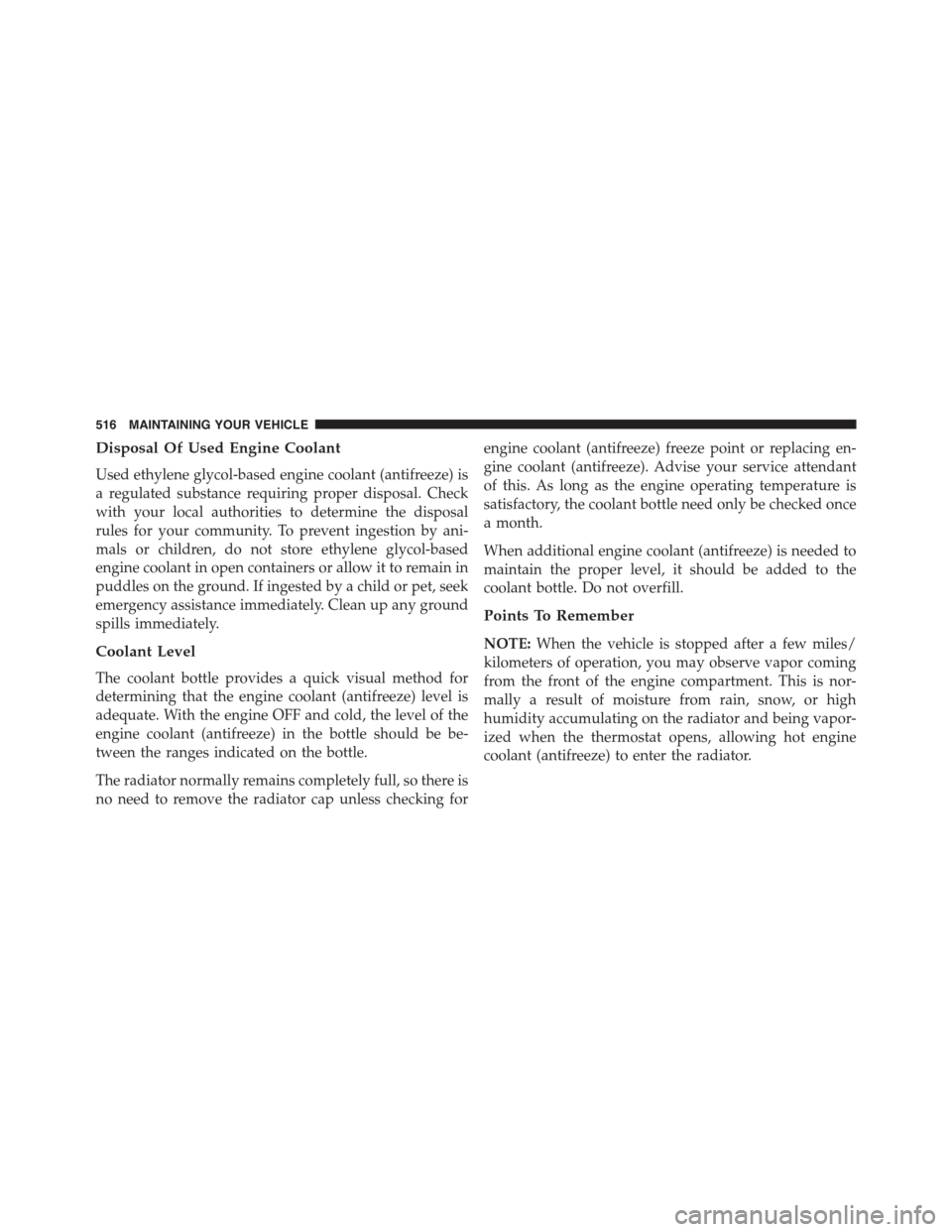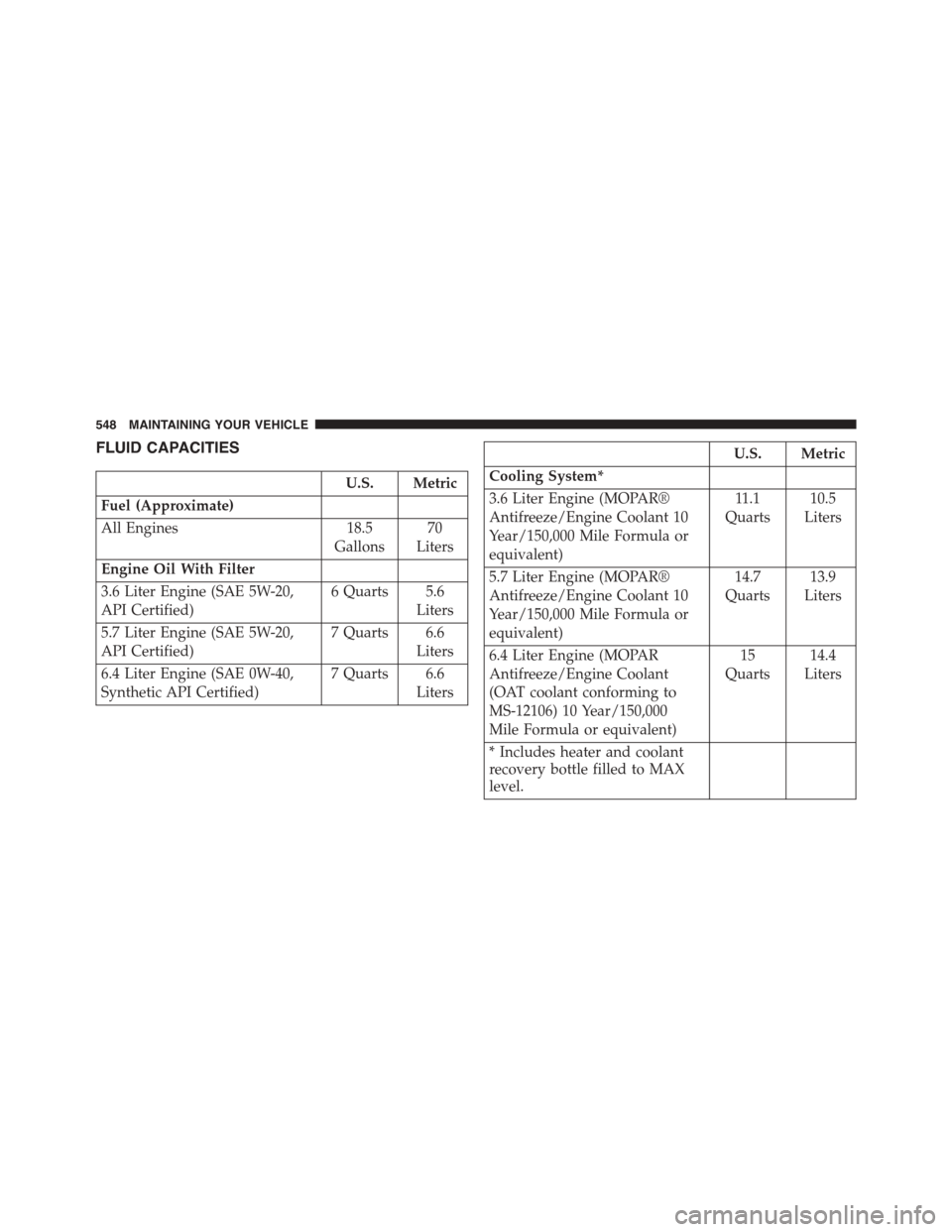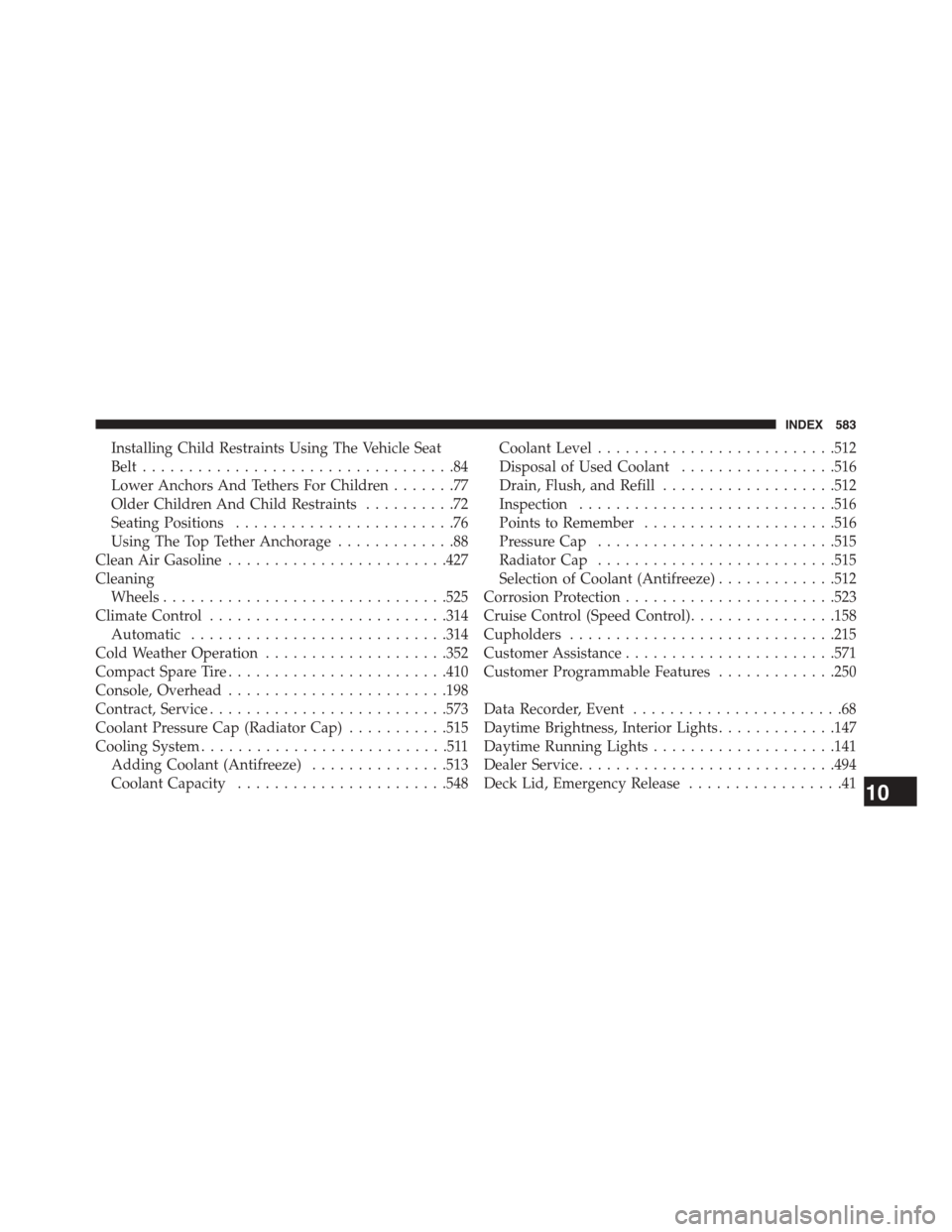2015 DODGE CHALLENGER coolant level
[x] Cancel search: coolant levelPage 231 of 603

10. Air Bag Warning Light
This light will turn on for four to eight seconds
as a bulb check when the ignition switch is first
turned to the ON/RUN position. If the light is
either not on during starting, stays on, or turns
on while driving, have the system inspected at an autho-
rized dealer as soon as possible. Refer to “Occupant
Restraints” in “Things To Know Before Starting Your
Vehicle” for further information.
11. Speedometer
Indicates vehicle speed.
12. Front Fog Light Indicator — If Equipped
This indicator will illuminate when the front fog
lights are on.
13. High Beam Indicator
This indicator will turn on when the high beam
headlights are on. Push the multifunction lever
away from the steering wheel to switch the headlights to
high beam.
14. Park/Headlight ON Indicator
This indicator will illuminate when the park
lights or headlights are turned on.
15. Fuel Gauge
The pointer shows the level of fuel in the fuel tank when
the ignition switch is placed in the ON/RUN position.
16. Temperature Gauge
The temperature gauge shows engine coolant tempera-
ture. Any reading within the normal range for a fully
warm vehicle should be 200 F - 230 F which indicates that
the engine cooling system is operating satisfactorily.
4
UNDERSTANDING YOUR INSTRUMENT PANEL 229
Page 516 of 603

you use the same engine coolant (OAT coolant conform-
ing to MS-12106) throughout the life of your vehicle.
Please review these recommendations for using Organic
Additive Technology (OAT) engine coolant (antifreeze)
that meets the requirements of Chrysler Material Stan-
dard MS-12106. When adding engine coolant (antifreeze):
•We recommend using MOPAR® Antifreeze/Coolant
10 Year/150,000 Mile Formula OAT (Organic Additive
Technology) that meets the requirements of Chrysler
Material Standard MS-12106.
•Mix a minimum solution of 50% OAT engine coolant
that meets the requirements of Chrysler Material Stan-
dard MS-12106 and distilled water. Use higher concen-
trations (not to exceed 70%) if temperatures below
−34° F (−37° C) are anticipated.
•Use only high purity water such as distilled or deion-
ized water when mixing the water/engine coolant
(antifreeze) solution. The use of lower quality water
will reduce the amount of corrosion protection in the
engine cooling system.
Please note that it is the owner’s responsibility to main-
tain the proper level of protection against freezing ac-
cording to the temperatures occurring in the area where
the vehicle is operated.
NOTE:
•Some vehicles require special tools to add coolant
properly. Failure to fill these systems properly could
lead to severe internal engine damage. If any coolant is
needed to be added to the system please contact your
local authorized dealer.
•Mixing engine coolant (antifreeze) types is not recom-
mended and can result in cooling system damage. If
514 MAINTAINING YOUR VEHICLE
Page 518 of 603

Disposal Of Used Engine Coolant
Used ethylene glycol-based engine coolant (antifreeze) is
a regulated substance requiring proper disposal. Check
with your local authorities to determine the disposal
rules for your community. To prevent ingestion by ani-
mals or children, do not store ethylene glycol-based
engine coolant in open containers or allow it to remain in
puddles on the ground. If ingested by a child or pet, seek
emergency assistance immediately. Clean up any ground
spills immediately.
Coolant Level
The coolant bottle provides a quick visual method for
determining that the engine coolant (antifreeze) level is
adequate. With the engine OFF and cold, the level of the
engine coolant (antifreeze) in the bottle should be be-
tween the ranges indicated on the bottle.
The radiator normally remains completely full, so there is
no need to remove the radiator cap unless checking for
engine coolant (antifreeze) freeze point or replacing en-
gine coolant (antifreeze). Advise your service attendant
of this. As long as the engine operating temperature is
satisfactory, the coolant bottle need only be checked once
a month.
When additional engine coolant (antifreeze) is needed to
maintain the proper level, it should be added to the
coolant bottle. Do not overfill.
Points To Remember
NOTE:When the vehicle is stopped after a few miles/
kilometers of operation, you may observe vapor coming
from the front of the engine compartment. This is nor-
mally a result of moisture from rain, snow, or high
humidity accumulating on the radiator and being vapor-
ized when the thermostat opens, allowing hot engine
coolant (antifreeze) to enter the radiator.
516 MAINTAINING YOUR VEHICLE
Page 550 of 603

FLUID CAPACITIES
U.S. Metric
Fuel (Approximate)
All Engines18.5
Gallons
70
Liters
Engine Oil With Filter
3.6 Liter Engine (SAE 5W-20,
API Certified)
6 Quarts 5.6
Liters
5.7 Liter Engine (SAE 5W-20,
API Certified)
7 Quarts 6.6
Liters
6.4 Liter Engine (SAE 0W-40,
Synthetic API Certified)
7 Quarts 6.6
Liters
U.S. Metric
Cooling System*
3.6 Liter Engine (MOPAR®
Antifreeze/Engine Coolant 10
Year/150,000 Mile Formula or
equivalent)
11.1
Quarts
10.5
Liters
5.7 Liter Engine (MOPAR®
Antifreeze/Engine Coolant 10
Year/150,000 Mile Formula or
equivalent)
14.7
Quarts
13.9
Liters
6.4 Liter Engine (MOPAR
Antifreeze/Engine Coolant
(OAT coolant conforming to
MS-12106) 10 Year/150,000
Mile Formula or equivalent)
15
Quarts
14.4
Liters
* Includes heater and coolant
recovery bottle filled to MAX
level.
548 MAINTAINING YOUR VEHICLE
Page 557 of 603

Once A Month Or Before A Long Trip:
•Check engine oil level
•Check windshield washer fluid level
•Check tire pressure and look for unusual wear or
damage. Rotate tires at the first sign of irregular wear,
even if it occurs before your next scheduled service.
•Check the fluid levels of the coolant reservoir, brake
master cylinder, and power steering and fill as needed.
•Check function of all interior and exterior lights
Required Maintenance Intervals.
Refer to the maintenance schedules on the following
page for the required maintenance intervals.
At Every Oil Change Interval As Indicated By Oil
Change Indicator System:
•Change oil and filter
•Rotate the tires.Rotate at the first sign of irregular
wear, even if it occurs before your next scheduled
service
•Inspect battery and clean and tighten terminals as
required
•Inspect brake pads, shoes, rotors, drums, hoses
and park brake
•Inspect engine cooling system protection and
hoses
•Inspect exhaust system
•Inspect engine air cleaner if using in dusty or
off-road conditions
8
MAINTENANCE
SCHEDULES
MAINTENANCE SCHEDULES 555
Page 565 of 603

Once A Month
•Check tire pressure and look for unusual wear or
damage.
•Inspect the battery, and clean and tighten the terminals
as required.
•Check the fluid levels of the coolant reservoir, brake
master cylinder, and power steering, and add as
needed.
•Check all lights and other electrical items for correct
operation.
At Each Oil Change
•Change the engine oil filter.
•Inspect the brake hoses and lines.
CAUTION!
Failure to perform the required maintenance items
may result in damage to the vehicle.
8
MAINTENANCE
SCHEDULES
MAINTENANCE SCHEDULES 563
Page 583 of 603

Alterations/Modifications, Vehicle...............7
Antifreeze (Engine Coolant)..................512
Disposal..............................516
Anti-Lock Brake System (ABS)................382
Anti-Lock Warning Light....................225
Appearance Care.........................523
Arming System (Security Alarm)...............18
Auto Down Power Windows..................38
Automatic Door Locks......................31
Automatic Headlights......................139
Automatic High Beams.....................139
Automatic Temperature Control (ATC)..........314
Automatic Transmission....................362
Adding Fluid..........................522
Autostick.............................369
Fluid and Filter Changes..................522
Fluid Change..........................522
Fluid Level Check.......................522
Fluid Type............................552
Special Additives.......................521
Automatic Transmission Limp Home Mode.......368
Autostick...............................369
Auto Unlock, Doors........................32
Axle Fluid..............................552
Axle Lubrication..........................552
Battery.................................502
Keyless Transmitter Replacement (RKE)........24
Location..............................502
Belts, Seat...............................95
Body Mechanism Lubrication.................507
B-Pillar Location..........................398
Brake Assist System.......................385
Brake Control System, Electronic..............381
Brake Fluid.............................552
Brake, Parking...........................377
Brakes.................................381
Brake System............................38110
INDEX 581
Page 585 of 603

Installing Child Restraints Using The Vehicle Seat
Belt..................................84
Lower Anchors And Tethers For Children.......77
Older Children And Child Restraints..........72
Seating Positions........................76
Using The Top Tether Anchorage.............88
Clean Air Gasoline........................427
Cleaning
Wheels...............................525
Climate Control..........................314
Automatic............................314
Cold Weather Operation....................352
Compact Spare Tire........................410
Console, Overhead........................198
Contract, Service..........................573
Coolant Pressure Cap (Radiator Cap)...........515
Cooling System...........................511
Adding Coolant (Antifreeze)...............513
Coolant Capacity.......................548
Coolant Level..........................512
Disposal of Used Coolant.................516
Drain, Flush, and Refill...................512
Inspection............................516
Points to Remember.....................516
Pressure Cap..........................515
Radiator Cap..........................515
Selection of Coolant (Antifreeze).............512
Corrosion Protection.......................523
Cruise Control (Speed Control)................158
Cupholders.............................215
Customer Assistance.......................571
Customer Programmable Features.............250
Data Recorder, Event.......................68
Daytime Brightness, Interior Lights.............147
Daytime Running Lights....................141
Dealer Service............................494
Deck Lid, Emergency Release.................4110
INDEX 583